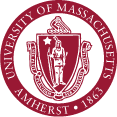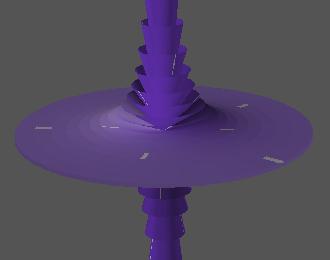NOTE At the Organizational meeting on Wednesday Feb 5, it was
decided to move TWIGS to Mondays 12:10-1:10 to accomodate the largest
number of participants. But the first couple of talks were already
scheduled and will meet on Wednesdays 3-4 pm in 1634 LGRT.
Here is the schedule of talks for TWIGS Fall 2002.
Spring 2003 Schedule:
| |  |
12 February |
Luc Rey-Bellet,
UMass Amherst(Wednesday Edition, 1634 LGRT) |
| |
3:00-4:00
|
What Is The Ergodic Theorem?
|
| |
|
| |  |
26 February |
Jim Humphreys,
UMass Amherst (Wednesday Edition, 1634 LGRT) |
| |
3:00-4:00
|
What Is a Quiver?
|
| |
|
| |  |
03 March |
Farshid Hajir,
UMass Amherst (Monday Edition, 125 LGRT) |
| |
12:10-1:10
|
What Is a p-adic number?
|
| |
|
| |  |
10 March |
Frank Sottile,
UMass Amherst (Monday Edition, 125 LGRT) |
| |
12:10-1:10
|
What Is a Real Algebraic Curve?
|
| |
|
| |  |
24 March |
Farshid Hajir,
UMass Amherst (Monday Edition, 125 LGRT) |
| |
12:10-1:10
|
What Is an Elliptic Curve?
|
| |
|
| |  |
31 March |
Franz Pedit,
UMass Amherst (Monday Edition, 125 LGRT) |
| |
12:10-1:10
|
What Is A Surface of Constant Mean Curvature (CMC)?
|
| |
|
| |  |
7 April |
John Staudenmayer,
UMass Amherst (Monday Edition, 125 LGRT) |
| |
12:10-1:10
|
What Is a Monte Carlo Markov Chain (MCMC)?
|
| |
|
| |  |
9 April |
Arpad Benyi,
UMass Amherst (Wednesday Edition, 1634 LGRT) |
| |
3:00-4:00
|
What Is Calderon's Reproducing Formula?
|
| |
|
| |  |
16 April |
Greg Warrington,
UMass Amherst (Wednesday Edition, 1634 LGRT) |
| |
3:00-4:00
|
What Is a Hyperplance Arrangement?
|
| |
|
| |  |
23 April |
John Fogarty,
UMass Amherst (Wednesday Edition, 1634 LGRT) |
| |
!!4:30-5:30!!
|
What Is a Chow Point?
|
| |
|
| |  |
28 April |
Chris Raphael,
UMass Amherst (Monday Edition, 125 LGRT) |
| |
12:10-1:10
|
What Is a Hidden Markov Model?
|
| |
|
| |  |
5 May |
Bill Meeks,
UMass Amherst (Monday Edition, 125 LGRT) |
| |
12:10-1:10
|
What Are Minimal Surfaces And What Does Classifying Them Mean?
|
| |
|
Abstracts
12 February
Luc Rey-Bellet, UMass Amherst
What Is The Ergodic Theorem?
Abstract
Ergodic theory is the study of maps or flows which preserve a
measure. We will explain the concepts of recurrence, ergodicity and
mixing, discuss the ergodic theorem of Birkhoff and present several simple
examples (rotation of the circle and expanding maps of the circle). We
will keep the discussion at an elementary level.
TOP
26 February
Jim Humphreys, UMass Amherst
What Is a Quiver?
Abstract
A quiver is just a directed graph (with cycles permitted), not by
itself a complicated mathematical object. But it provides a starting
point for deeper investigations, when "representations" of quivers are
studied. A representation of a quiver involves placing a vector space
at each vertex and assigning a linear map to each arrow. In 1971
Peter Gabriel found a striking connection between indecomposable
representations of quivers and Dynkin diagrams of types A, D, E for
simple Lie algebras. Similar ideas were being explored independently
by I.M. Gelfand's school in Moscow, in connection with problems of
linear algebra. Since then other uses have been found for quivers,
for example in the work of Claus Ringel and George Lusztig on bases
for quantized enveloping algebras. Just last month the AMS Cole Prize
in Algebra was awarded to Hiraku Nakajima, in part for his
introduction of "quiver varieties" in 1994. This talk will focus on
the basic ideas about quivers, but with a few indications of the later
developments.
TOP
03 March
Farshid Hajir, UMass Amherst
What Is a p-adic number?
Abstract
In addition to the usual metric on the rational numbers, there is,
for each prime p, a "p-adic" metric. The completion of the
rational numbers under the p-adic metric is called the field
of p-adic numbers; it is an important object in number theory.
Its "integers" can be thought of as numbers
having infinite base-p expansion. The p-adic metric satisfies
a strong form of the triangle inequality with many amusing
consequences: for instance, every p-adic triangle is isosceles
and a series converges p-adically if and only if its terms go
to zero. I'll give examples of the local-global principle
in number theory whereby certain equations are solvable in Q
if and only if they are solvable p-adically for all p.
TOP
10 March
Frank Sottile, UMass Amherst
What Is a Real Algebraic Curve?
Abstract
A real algebraic plane curve is the set of real solutions to
a polynomial equation f(x,y)=0. Their topology and classification
was one of Hilbert's problems in 1900, and their study
continues to be an active area of mathematical research.
For example, plane curves will play a major role in
Winter/Spring 2004 program at the Mathematical Sciences
Research Institute on Topological aspects of real algebraic
varieties. This talk will introduce you to them and to the
beginnings of their study.
TOP
24 March
Farshid Hajir, UMass Amherst
What Is an Elliptic Curve?
Abstract
An elliptic curve over a field F is a smooth curve of genus 1 over F
equipped with a point on the curve defined over F. The set of
points on the curve with coordinates in F forms an abelian
group under a natural addition law. I'll describe the space
of elliptic curves over the complex numbers and describe how
this space can be viewed from analytic, geometric and
arithmetic perspectives.
TOP
31 March
Franz Pedit, UMass Amherst
What Is A Surface of Constant Mean Curvature (CMC)?
Abstract
I will explain the theory, experiments, and visualization of surfaces
of constant mean curvature.
TOP
7 April
John Staudenmayer, UMass Amherst
What Is a Monte Carlo Markov Chain?
Abstract
A monte carlo markov chain (MCMC) is a method that can be used to simulate
quasi random variables from almost any distribution. By way of example,
I'll show what a Monte Carlo Markov Chain is, sketch why it works, and
illustrate one way in which it can be useful (Bayesian statistics). Along
the way, I'll introduce what we need from markov chain theory and Bayesian
statistics.
[Stay tuned for "What is a CMCMC?" and "What is an MCMCMC?"...]
TOP
9 April
Arpad Benyi, UMass Amherst
What Is Calderon's Reproducing Formula?
Abstract
Calderon's reproducing formula first appeared in a paper of
Calderon from the 60's on complex interpolation. The basic idea is to
write a function as a convenient "sum" of convolutions. The formula
was motivated by some classical theory, which we plan to outline. We will
then proceed with the proof of the formula. The talk only requires a basic
knowledge of Fourier Analysis.
TOP
16 April
Greg Warrington, UMass Amherst
What Is A Hyperplane Arrangement?
Abstract
A hyperplane arrangement is a collection of (codimension 1) slices
through n-dimensional space. The study of these simple sounding
objects leads to interesting and fundamental notions in combinatorics,
algebra and topology. I will define hyperplane arrangements and focus
on their combinatorial aspects. In particular, I'll explain how they
relate to the Four-Color Theorem.
TOP
23 April
John Fogarty, UMass Amherst
What Is A Chow Point?
Abstract
Brief discussion of Chow coordinates and an application by E. Noether
to invariant theory in characteristic 0. Problems in characteristic p.
TOP
28 April
Chris Raphael, UMass Amherst
What Is A Hidden Markov Model?
Abstract
I will introduce the hidden Markov model --- a probabilistic
graphical model used for many recognition problems such as
speech and optical character recognition. HMMs are useful
primarily due to the way they interweave modeling flexibility
with computation. I will show an application to automatic musical
accompaniment and give a live demonstration.
TOP
05 May
Bill Meeks, UMass Amherst
What Are Minimal Surfaces and What Does Classifying Them Mean?
Abstract
I will explain some of the basic equivalent descriptions of
classical minimal surfaces in R^3. Also, i will describe some of the
famous classical examples found in previous centuries. I will try to
explain to what extent these famous examples are unique, based on recent
results by myself and others.
TOP
The picture above was created by
Paul Gunnells.
It visualizes the natural action of the group
of units of a complex cubic field on 3-space.
Consult
Paul for more details.
Last modified: 11 February 2003 by
Farshid Hajir


 Most Meetings are on Mondays 12:10-1:10
in LGRT 125
Most Meetings are on Mondays 12:10-1:10
in LGRT 125
 Driving Directions and
Campus Maps
Driving Directions and
Campus Maps
 Overview of the Seminar
Overview of the Seminar
